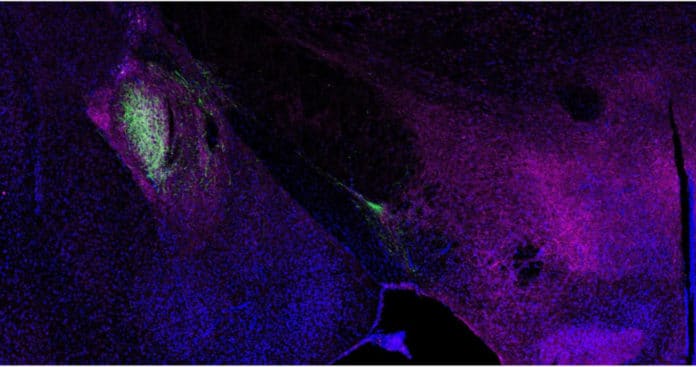The central nucleus of the amygdala is known to play a vital role in alcohol use and other affective disorders. Although, the genetically-defined neuronal subtypes and their projections that govern these behaviors are not well known.
Now, a new study discovered a set of neurons in the central nucleus of the amygdala (CeA) that are responsible for reward-like behaviors, alcohol consumption in particular.
Senior author Zoe McElligott, Ph.D., assistant professor of psychiatry and pharmacology said, “The fact that these neurons promote reward-like behavior, that deficient levels of alcohol consumption activate these cells, and that activation of these neurons drive alcohol drinking in animals without extensive prior drinking experience suggests that they may be important for early alcohol use and reward.”
“We hope that by understanding the function of this circuit, we can better predict what happens in the brains of people who transition from casual alcohol use to subsequent abuse of alcohol, and the development of alcohol use disorders.”
Scientists were keen to know if a set of neurons that express a specific neuropeptide (neurotensin or NTS) contributes to reward-like behaviors and alcohol drinking. They were interested in these neurons in the context of new alcohol use, such as when a person first begins to drink alcohol.
Also, NTS neurons are a subpopulation of other neurons in this CeA brain region that have been implicated in anxiety and fear – known as the somatostatin and corticotropin-releasing factor neurons.
The study was conducted on male mice using modern genetic and viral technologies. Scientists found that specifically lesioning or removing the NTS neurons in the CeA, while maintaining different kinds of CeA neurons, would make the animals drink less alcohol. This control didn’t alter anxiety-like behavior. It likewise didn’t influence the utilization of other palatable liquids, for example, sucrose, saccharin, and bitter quinine solutions.
McElligott said, “We found that these NTS neurons in the CeA send a strong projection to the hindbrain, where they inhibit the parabrachial nucleus, near the brainstem.”
Later by using optogenetics, scientists tracked the light that activates these neurons and simulated the terminal projections of the CeA-NTS neurons in the parabrachial and found that this stimulation inhibited the neurons in the parabrachial. Simulating the projection with a laser in one half of the animal’s box, animals would spend more time where the stimulation would occur.
Animals also learned to perform a task to get the laser stimulation to turn on, and they would do this repeatedly, suggesting that they found this stimulation to be rewarding.
McElligott said, “Furthermore, when we stimulated this projection, animals would drink more alcohol as compared to when they had an opportunity to drink alcohol without laser stimulation. In contrast to our study, where we ablated the NTS neurons, laser stimulation of this parabrachial pathway also caused the animals to consume caloric and non-caloric sweetened beverages. When the animals were presented with regular food and sweet food, however, laser stimulation did not enhance the consumption regardless of the mouse’s hunger state. This suggests that different circuits may regulate the consumption of rewarding fluids and solids.”
This study paves the way towards exploring how alcohol experience may change these neurons over time.
